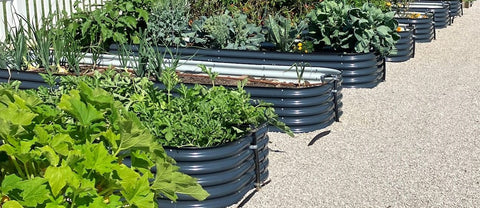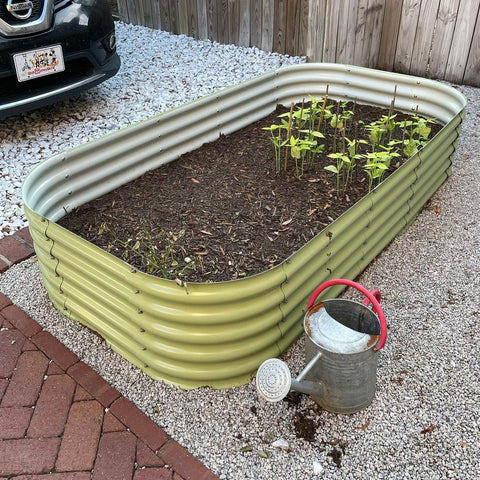Plant And Growing A Vegetable Garden in Containers or Garden Beds
Don't have space for a traditional garden? Try planting and planting a vegetable garden in a container or in a garden bed. One major benefit: you can place the container anywhere there is sunlight – even on a terrace, deck, driveway, balcony or roof. When you can place a container or garden bed wherever you like, there is no need to worry about too much shade.
Over the years, container gardening and garden beds have become increasingly popular. While ornamental plants are often the plants of choice, more and more people are finding that vegetables and herbs also have a place in containers and garden beds. Here are a few reasons to try growing a vegetable garden in a container or garden bed, along with some tips to help along the way.

Benefits of container gardening
If you're a beginner, container gardening is an inexpensive way to try a vegetable or herb garden.
You can create gardening spaces in places that you didn't have before, such as on decks, patios, or on bending over.
The container promotes optimal plant growth when filled with a lightweight, nutrient-dense potting mixture.
If your plants need more or less sunlight, you can easily move the container.
Container gardening extends the growing season, because if frosts are due, you can temporarily store the garden in the garage.
The container simplifies watering by pooling all the moisture to the root zone instead of letting it run away.
You can use almost any container, including barrels, bins, semi-wine barrels, old gutters, or plastic nursery jars.
The container reduces the need to weed around the plant.
Containers can reduce pests such as snails and slugs.
Tips for gardening vegetables in containers or garden beds
Choose the right pot
You can use almost any container that can hold the soil, as long as it has drainage holes (vegetables and herbs don't like soil that is often moist). You can repurpose old plastic nursery pots; Consult a horticulturist who specializes in tree planting to get an oversized plastic pot that's perfect for container gardening.

Watering plan
The biggest challenge in container gardening is watering. This is because the soil dries faster in pots than in the ground. Choose the largest pot you can find so you have more soil to retain moisture. You can also put one pot in another so that the sun does not heat the surface of the container and bake the soil. You can consider grouping containers - they are easier to water, and the outermost pot shades the container behind them.
Since potted plants usually require daily watering, you can simplify the task by using self-watering containers. They provide additional water for the plants, and the reservoir sits below the grid that covers the soil at the top. You don't have to water every day, but you need to keep the reservoir full. Another sensible water idea: Cover bare soil with mulch to slow water evaporation.
Use a potting soil mixture
Simplify everything by filling containers or garden beds with a quality soilless potting mixture that has slow-release fertilizer and retains moisture well. You won't worry too much about when to fertilize – and if you miss a day of watering, you don't have to worry.
Seek the light
The container allows people with shady gardens to grow edible plants. Just place the container garden or garden bed in a sunny place. You can even put a few of them on carts, vans, or other equipment on wheels and follow the sun in the yard.
Decide what to plant
When growing vegetables in containers, keep in mind that some are easier than others. If you have a large sink, you can grow corn, but there are simpler bets that don't require as much space, including arugula, beets, bush beans, chives, kale, eggplant, kale, peppers, turnips, sweet potatoes, and Swiss chards.
Start with herbs
Herbs are easy to grow in containers, especially if you start with seedlings and can add freshly grown flavor to almost any meal. You can place herbs in a convenient place near the kitchen to invite "cut and harvest again". Just remember to give them the conditions they like: plenty of sunlight and well-drained soil.
Many herbs also work well as companion plants in containers. Examples include basil with tomatoes, variegated sage with morning glory and thyme with marigold. You can also get more productivity and more aesthetics.
Upgrade with greens
Tender green vegetables, such as lettuce and spinach, are among the simplest. You can get them off to a quick start because they actually prefer the cooler temperatures of spring. Sow seeds in pots. They take a week or more to germinate but will soon reach a harvest size of 3 to 4 inches. Use scissors to cut off only the largest leaves and let your harvest last six to eight weeks – or longer if the temperature is cooler. Eventually, the plants will tie up, or go to sow seeds, at which point you can pull them up, let the pots fallow for a month or two, and then sow the fall crops.

Challenge yourself with tomatoes
Tomatoes may require some work to grow as container vegetables. Be sure to look for varieties that are especially recommended for containers or garden beds. In general, these are "definite", which means that they grow to a certain size, and then within a few weeks they stop and bear all the fruit. Cherry tomatoes also work great in pots, and you'll love the convenience of having a pot or two outside the back door. Use large containers 18 to 24 inches in diameter and include a tomato cage as support.
Planting a vegetable garden in a container or in a garden bed can be a great way to start a vegetable garden or take your vegetable garden to the next level.
